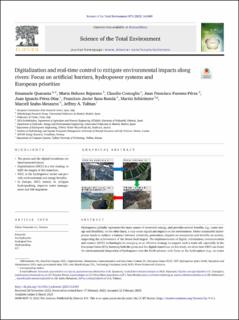Digitalization and real-time control to mitigate environmental impacts along rivers: Focus on artificial barriers, hydropower systems and European priorities
| dc.contributor.author | Quaranta, Emanuele | |
| dc.contributor.author | Bejarano, Maria Dolores | |
| dc.contributor.author | Comoglio, Claudio | |
| dc.contributor.author | Fuentes-Pérez, Juan Francisco | |
| dc.contributor.author | Perez-Diaz, Juan I. | |
| dc.contributor.author | Sanz-Ronda, Francisco Javier | |
| dc.contributor.author | Schletterer, Martin | |
| dc.contributor.author | Szabo-Meszaros, Marcell | |
| dc.contributor.author | Tuhtan, Jeffrey | |
| dc.date.accessioned | 2023-04-27T13:34:20Z | |
| dc.date.available | 2023-04-27T13:34:20Z | |
| dc.date.created | 2023-03-14T11:08:33Z | |
| dc.date.issued | 2023 | |
| dc.identifier.issn | 0048-9697 | |
| dc.identifier.uri | https://hdl.handle.net/11250/3065374 | |
| dc.description.abstract | Hydropower globally represents the main source of renewable energy, and provides several benefits, e.g., water storage and flexibility; on the other hand, it may cause significant impacts on the environment. Hence sustainable hydropower needs to achieve a balance between electricity generation, impacts on ecosystems and benefits on society, supporting the achievement of the Green Deal targets. The implementation of digital, information, communication and control (DICC) technologies is emerging as an effective strategy to support such a trade-off, especially in the European Union (EU), fostering both the green and the digital transitions. In this study, we show how DICC can foster the environmental integration of hydropower into the Earth spheres, with focus on the hydrosphere (e.g., on water quality and quantity, hydropeaking mitigation, environmental flow control), biosphere (e.g., improvement of riparian vegetation, fish habitat and migration), atmosphere (reduction of methane emissions and evaporation from reservoirs), lithosphere (better sediment management, reduction of seepages), and on the anthroposphere (e.g., reduction of pollution associated to combined sewer overflows, chemicals, plastics and microplastics). With reference to the abovementioned Earth spheres, the main DICC applications, case studies, challenges, Technology Readiness Level (TRL), benefits and limitations, and transversal benefits for energy generation and predictive Operation and Maintenance (O&M), are discussed. The priorities for the European Union are highlighted. Although the paper focuses primarly on hydropower, analogous considerations are valid for any artificial barrier, water reservoir and civil structure which interferes with freshwater systems. | en_US |
| dc.description.abstract | Digitalization and real-time control to mitigate environmental impacts along rivers: Focus on artificial barriers, hydropower systems and European priorities | en_US |
| dc.language.iso | eng | en_US |
| dc.publisher | Elsevier | en_US |
| dc.rights | Navngivelse 4.0 Internasjonal | * |
| dc.rights.uri | http://creativecommons.org/licenses/by/4.0/deed.no | * |
| dc.title | Digitalization and real-time control to mitigate environmental impacts along rivers: Focus on artificial barriers, hydropower systems and European priorities | en_US |
| dc.title.alternative | Digitalization and real-time control to mitigate environmental impacts along rivers: Focus on artificial barriers, hydropower systems and European priorities | en_US |
| dc.type | Peer reviewed | en_US |
| dc.type | Journal article | en_US |
| dc.description.version | publishedVersion | en_US |
| dc.rights.holder | The Authors | en_US |
| dc.source.volume | 875 | en_US |
| dc.source.journal | Science of the Total Environment | en_US |
| dc.identifier.doi | 10.1016/j.scitotenv.2023.162489 | |
| dc.identifier.cristin | 2133741 | |
| dc.relation.project | EC/H2020/101032024 | en_US |
| dc.source.articlenumber | 162489 | en_US |
| cristin.ispublished | true | |
| cristin.fulltext | original | |
| cristin.qualitycode | 2 |
Tilhørende fil(er)
Denne innførselen finnes i følgende samling(er)
-
Publikasjoner fra CRIStin - SINTEF Energi [1614]
-
SINTEF Energi [1731]

